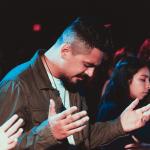The lights dim, and the band takes the stage.The worship leader welcomes the crowd with a boisterous “Hey, how’s everyone doin’? Great to see you all!” before the band slips into a booming, clever cover of a pop song, then segues into a couple of modern sing-a-long worship standards pulled right from heavy rotation on the positive, encouraging Christian radio station.
A carefully-curated selection of announcements and a prayer follows, creating space for ushers/hosts to collect the offering while an emotional musical solo backed by acoustic instruments creates a more intimate mood in the cavernous room. A slickly-produced three-minute video sets up the sermon, which is the main course for the gathering. It focuses on addressing everyday needs of the crowd (relationships, finances, time management). A call to action wraps up the message. The crowd is charged to do something or change something in their lives in the coming week, a brief prayer in the form of a benediction may be offered, and the band returns to the stage to play the crowd up-tempo out of the auditorium.
If you’ve attended a seeker-sensitive church, you’ve probably seen some form of this liturgy. Mega-churches have mastered it, and occasionally improvise on elements of it, adding a bit of live drama, an evocative dance number or an arresting spoken word piece, all with high-tech bells and whistles in the form of theatrical lighting and smoke machines. Excellence and relevance drive the production each weekend. Smaller churches scale the seeker-sensitive liturgy to their size and reach, but always the emphasis is ensuring the weekend service experience is drained of church insider-jargon, mysterious-to-the-uninitiated rituals, and disconnect with “real life”. In short, church services in these congregations function as a commercial for Church.
In both Protestant and post-Vatican II Catholic churches, the impulse toward making corporate worship accessible picked up steam in the wake of the Jesus Movement of the late 1960’s and early 1970’s. New believers flooded into old churches like new wine into old wineskins. For most of Church history, liturgy had a transcendent quality to it. Even among low-church traditions, with services focused on sermons and simplicity of form, there was always meant to be a sense of the sacred. Traditional church services proclaimed, “It’s about God. Then it is about us, being formed as his people.”
The Jesus Movement turned these services upside down and inside out, crafting entirely new forms of liturgy that proclaimed, “It’s about you and getting you connected to God.” Author Sally Morgenthaler wrote the definitive textbook on Boomer seeker-sensitive worship as evangelism. Less than a decade later, she penned a profound reflection about where the movement had gone off the rails.
But the beat goes on. Mega churches to little start-ups meeting in rented gyms still follow the seeker-sensitive liturgy playbook, though it is most dominant in the Evangelical world in which it was birthed and continues to be refined. The Jesus Movement flooded the Evangelical and Charismatic world with young, committed Christ-followers wanting to make church services excellent and relevant to their not-yet-believing peers. A generation later, a growing number of believers have found that the mile-wide, inch-deep seeker liturgy isn’t reaching the people they hoped it would, and its shallowness is starving many of them of spiritual sustenance as well.
The Church is in a state of transition. This transition here is an opportunity for a bit of spiritual housecleaning that might create some space for reflection on the unintended consequences of some of our choices and desires. That is the focus of this ongoing series on the unintended consequences of the Jesus Movement. Today, I’d love to hear your thoughts on what we thought we were reaping with our seeker-sensitive liturgies – and what we’re sowing. What would you add to either of these lists?
What we hoped for when we created liturgy focused on the seeker:
- Acceptance – Unchurched Mary and Harry would find value in our gatherings and want to join us (and Jesus).
- Practicality – Unchurched Mary and Harry would discover that the Good News could help them with their problems.
- Relevance – Unchurched Mary and Harry would see that we were in constant conversation with pop culture, and not think of us as weirdo religious outliers.
- Creativity – Those old-school liturgies were b-o-r-i-n-g. Mary and Harry were used to being entertained.
- A Magnifying Mirror – Let’s be honest. Our seeker liturgies weren’t just about Mary and Harry. They were and are a reflection of us.
What we’re reaping a generation later:
- Predictability – Our seeker liturgies can be just as stagnant and lifeless as the older forms of liturgy we replaced them with.
- Rootlessness – Seeker liturgies tend to be light on actual Bible proclamation in favor of a few verses or a story. They may omit entirely most other elements of corporate worship such as congregational prayer, confession, communion, benediction. (Oddly, they still manage to receive an offering, which has never seemed especially seeker-sensitive to me.) There’s been a steady stream of those who grew up in seeker-sensitive churches moving to more traditional liturgical churches – and a river of those who’ve walked out the exit door, never to return because there was nothing other than flash and novelty holding them there.
- Cluelessness About Community – When everything we do in a church service is focused on the individual, we don’t rehearse and remember that we are part of the Body.
Your thoughts?
















